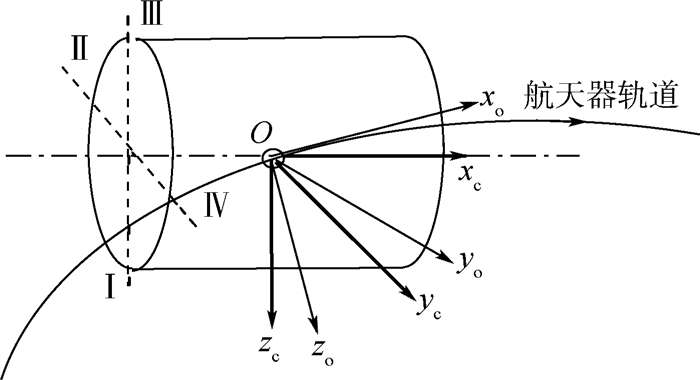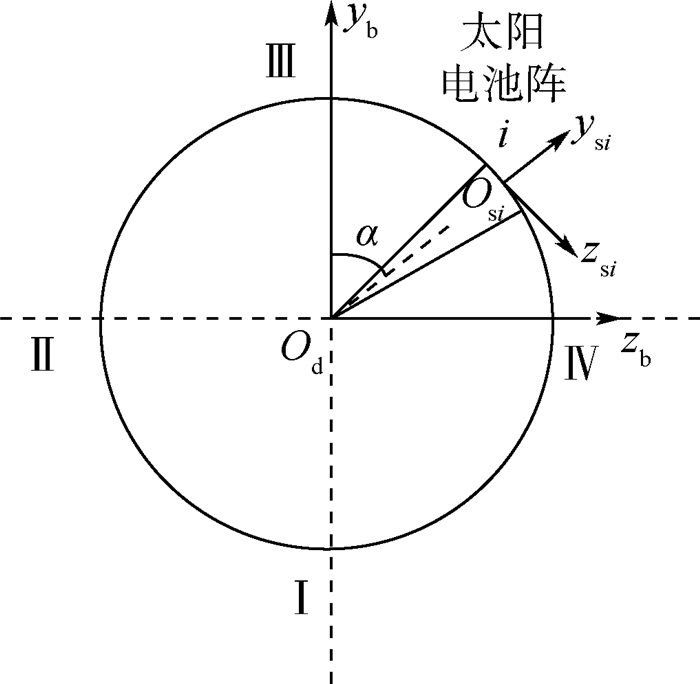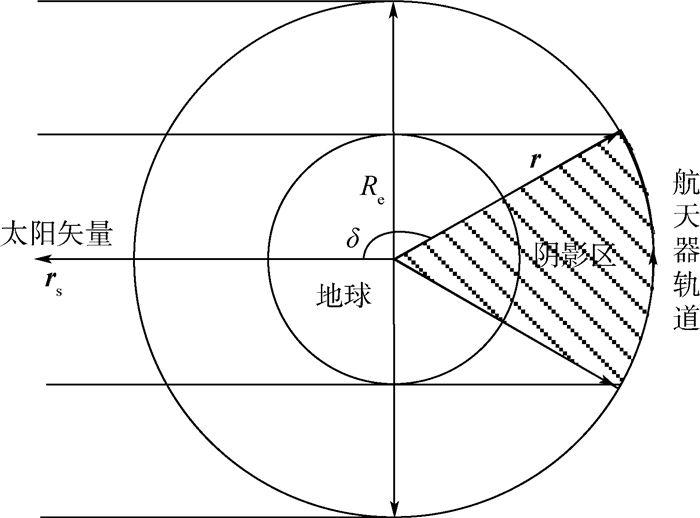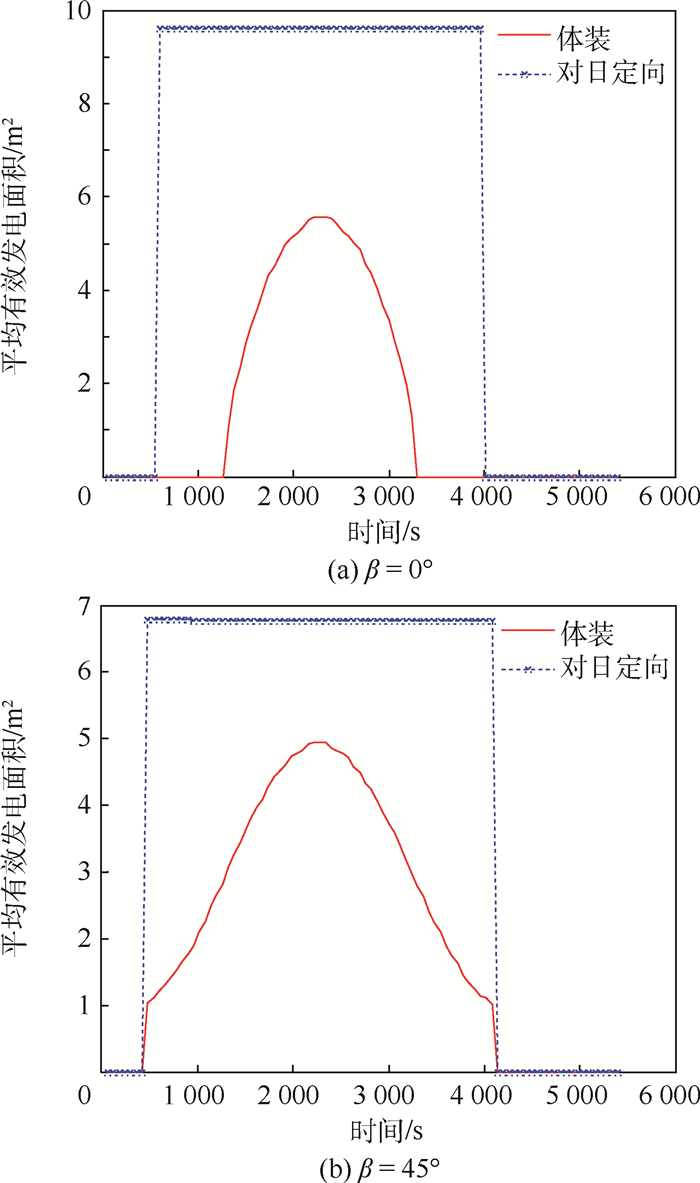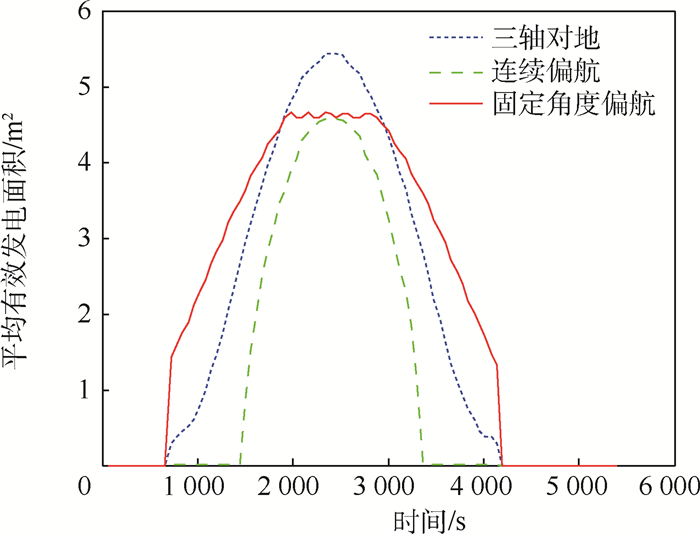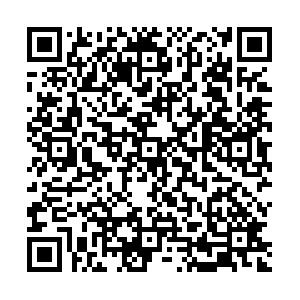A calculation method for effective power supply area of manned spacecraft with body mounted solar array
-
摘要:
航天器的发电能力与太阳电池阵有效发电面积成正比。针对圆柱形载人航天器,提出了一种体装太阳电池阵有效发电面积计算方法。首先,将太阳电池阵沿圆周方向划分为多个子阵,通过坐标变换,计算太阳矢量与每个子阵法线的夹角(即太阳入射角);然后,将每个子阵面积与对应太阳入射角的余弦相乘并求和,得到体装太阳电池阵的有效发电面积。对不同轨道日照角、不同飞行姿态下体装太阳电池阵有效发电面积进行仿真分析,仿真结果表明:三轴对地姿态下平均有效发电面积为安装面积的25%~32%,通过固定角度偏航可将有效发电面积提高至安装面积的30%~44%。
Abstract:The power supply capability is proportional to the effective area of spacecraft solar array. For cylindrical manned spacecraft, a calculation method for effective area of body mounted solar array is proposed. First, the mounted solar array was divided into
n parts along the circumference. The angle between the sun vector and the normal of each part (incidence angle) was calculated by coordinate transform. Then, the effective area of body mounted solar array was obtained by summing up the products of the area of each part and the cosine of incidence angle. Finally, the proposed method was verified by effective area simulation under different orbit sunlight angles and different flight attitudes for manned spacecraft with body mounted solar array. The simulation results show that the average effective area can reach 25%-32% of the mounted area under earth-oriented three-axis stabilized attitude the flight attitude of orientating the earth. By yawing the manned spacecraft with fixed angle, the ratio of effective area to mounted area can be expanded to 30%-44%. -
表 1 三轴对地飞行姿态下不同安装方式平均有效发电面积
Table 1. Average effective area for different installation ways under earth-oriented three-axis stabilized attitude
安装方式 平均有效发电面积/m2 β=0° β=30° β=45° β=63° 对日定向 9.6 8.3 6.8 4.3 体装 2.4(25%) 3.0(31%) 3.1(32%) 2.9(30%) 注:括号内为与太阳电池阵安装面积(9.6 m2)的比值。 表 2 不同飞行姿态下体装太阳电池阵平均有效发电面积
Table 2. Average effective power supply area of body mounted solar array under different flight attitudes
飞行姿态 平均有效发电面积/m2 β=0° β=30° β=45° β=63° 三轴对地 2.4 3.0 3.1 2.9 连续偏航 2.4(0%) 1.8(-40%) 1.2(-61%) 0.12(-96%) 固定角度偏航(90°) 4.2(+75%) 3.5(+17%) 2.6(-16%) 0.63(-78%) 注:括号内为相对三轴对地姿态下平均有效发电面积的变化量。 -
[1] 刘志全, 杨淑利, 濮海玲. 空间太阳电池阵的发展现状及趋势[J]. 航天器工程, 2012, 21(6): 112-118.LIU Z Q, YANG S L, PU H L. Development and trend of space solar array technology[J]. Spacecraft Engineering, 2012, 21(6): 112-118(in Chinese). [2] 李涛, 李伟, 杨雷. 一种航天器太阳电池阵供电能力计算方法[J]. 北京航空航天大学学报, 2017, 43(7): 1355-1363. doi: 10.13700/j.bh.1001-5965.2016.0600LI T, LI W, YANG L. A calculation method for power supply capability of spacecraft solar array[J]. Journal of Beijing University of Aeronautics and Astronautics, 2017, 43(7): 1355-1363(in Chinese). doi: 10.13700/j.bh.1001-5965.2016.0600 [3] 任筱强, 王鹏鹏. 航天器组合体能量平衡分析系统设计及应用[J]. 航天器工程, 2013, 22(2): 60-64. doi: 10.3969/j.issn.1673-8748.2013.02.012REN X Q, WANG P P. Design and implementation of energy balance analysis system for spacecraft combination[J]. Spacecraft Engineering, 2013, 22(2): 60-64(in Chinese). doi: 10.3969/j.issn.1673-8748.2013.02.012 [4] 陈忠贵, 张志, 廖瑛. 航天器太阳翼在轨光照角度建模及仿真分析[J]. 航天器工程, 2012, 21(1): 37-42. doi: 10.3969/j.issn.1673-8748.2012.01.010CHEN Z G, ZHANG Z, LIAO Y. Modeling and simulation analysis of solar illumination angle on spacecraft solar wing in-orbit[J]. Spacecraft Engineering, 2012, 21(1): 37-42(in Chinese). doi: 10.3969/j.issn.1673-8748.2012.01.010 [5] 万向成, 陆晴, 刘佩东. 斜装匀速对日驱动的卫星太阳电池阵入射角计算方法[J]. 航天器工程, 2017, 26(2): 38-44. doi: 10.3969/j.issn.1673-8748.2017.02.006WAN X C, LU Q, LIU P D. Method for calculating sunlight incident angle of solar array slanted mounted and driving with uniformly angular velocity[J]. Spacecraft Engineering, 2017, 26(2): 38-44(in Chinese). doi: 10.3969/j.issn.1673-8748.2017.02.006 [6] TEPPEI O, YASUSHI O, KIYOKAZU K, et al. Charging of the H-II transfer vehicle at rendezvous and docking phase[J]. Journal of Spacecraft and Rockets, 2018, 55(4): 971-983. doi: 10.2514/1.A34068 [7] JEREMY H. The international space station is expecting two visitors this month: Starliner and Crew Dragon[J]. IEEE Spectrum, 2018, 55(8): 6-8. doi: 10.1109/MSPEC.2018.8423570 [8] 林君毅, 尹兴月. 微小卫星无姿控下太阳电池阵输出功率研究[J]. 电源技术, 2012, 36(10): 1478-1480. doi: 10.3969/j.issn.1002-087X.2012.10.016LIN J Y, YIN X Y. Research of solar array output for the minisatellite without attinlde control[J]. Chinese Journal of Power Sources, 2012, 36(10): 1478-1480(in Chinese). doi: 10.3969/j.issn.1002-087X.2012.10.016 [9] 杨宏, 等. 载人航天器技术[M]. 北京: 北京理工大学出版社, 2017.YANG H, et al. Human spacecraft technology[M]. Beijing: Beijing Institute of Technology Press, 2017(in Chinese). [10] 崔鹏, 郄毅鹏, 尹兴月, 等. 大光照角入射对太阳电池阵的影响分析与验证[J]. 电源技术, 2014, 38(9): 1637-1639. doi: 10.3969/j.issn.1002-087X.2014.09.015CUI P, QIE Y P, YIN X Y, et al. Impact of large light angle on solar array and its verification[J]. Chinese Journal of Power Sources, 2014, 38(9): 1637-1639(in Chinese). doi: 10.3969/j.issn.1002-087X.2014.09.015 [11] 程保义. 空间三结砷化镓太阳电池辐照衰减模型研究[D]. 天津: 南开大学, 2010.CHENG B Y. Research on the radiation model of space triple-junction solar cell[D]. Tianjin: Nankai University, 2010(in Chinese). [12] 刘林. 航天器轨道理论[M]. 北京: 国防工业出版社, 2000.LIU L. Orbit theory of spacecraft[M]. Beijing: Defense Industry Press, 2000(in Chinese). [13] 李安寿, 张东来, 杨炀, 等. 一种精确计算航天器本体对太阳电池阵遮挡的方法[J]. 宇航学报, 2013, 34(10): 1403-1409. doi: 10.3873/j.issn.1000-1328.2013.10.015LI A S, ZHANG D L, YANG Y, et al. A method for accurately calculating the shadow of solar array shaded by spacecraft itself[J]. Journal of Astronautics, 2013, 34(10): 1403-1409(in Chinese). doi: 10.3873/j.issn.1000-1328.2013.10.015 [14] RAMAPRABHA R, MATHUR B L. A comprehensive review and analysis of solar photovoltaic array configurations under partial shaded conditions[J]. International Journal of Photoenergy, 2012, 12(6): 1-16. [15] 王颖, 顾荃莹. 倾斜轨道航天器太阳翼对日跟踪方法探讨[J]. 航天器工程, 2009, 18(3): 36-40.WANG Y, GU Q Y. Method of solar array tracking for inclined-orbit satellite[J]. Spacecraft Engineering, 2009, 18(3): 36-40(in Chinese). -








 下载:
下载:

